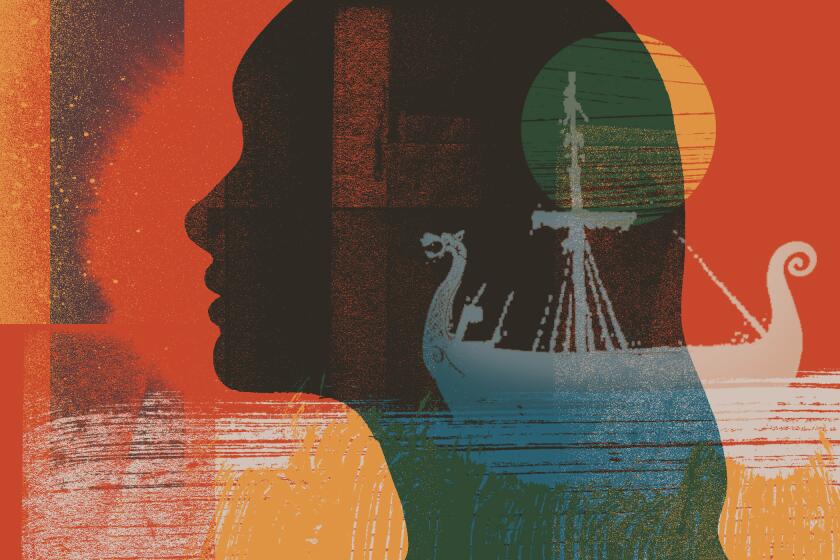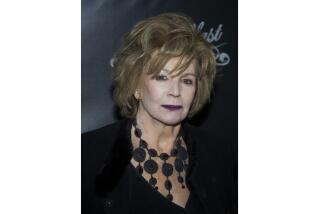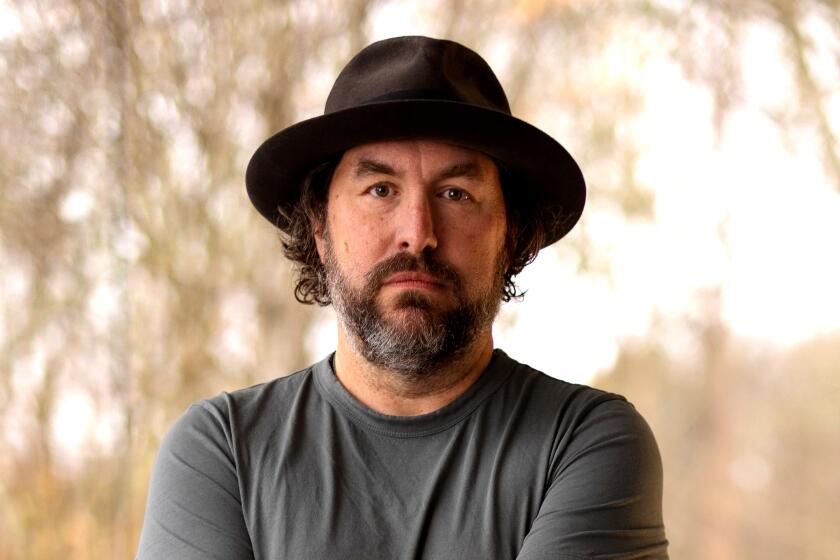Fiction or not, everything is true in Jo Ann Beard’s shape-shifting writing
On the Shelf
Festival Days
By Jo Ann Beard
Little, Brown: 272 pages, $27
If you buy books linked on our site, The Times may earn a commission from Bookshop.org, whose fees support independent bookstores.
“The last moment of my life, as I’m dying, I would like to smell a horse barn,” Jo Ann Beard tells me over a video chat. It’s not a surprising statement from the Midwesterner who now lives in pastoral Rhinebeck, N.Y., with her partner, the writer Scott Spencer, and two dogs, Beatrice and Jet. She’s just finished recalling a painful visit to the empty duck house in her backyard after most of its inhabitants were killed by a raccoon. (The sole survivor went to a farm sanctuary.)
“I thought of all those ducks that I loved so much,” Beard says. “And by the way, they never loved us, they were always afraid of us. They were, like, get away from me, get away from me! … But so what! I don’t care.”
I suggest that her relationship with the ducks is an apt metaphor for being a writer: so many thankless years piecing together one sentence after the other, not knowing how the work will be received.
“Exactly,” Beard agrees. “I was in service to them. I didn’t expect them to like me.”
Ducks come up several times in Beard’s latest book, “Festival Days,” a collection of creative nonfiction and short stories 20 years in the making. The title essay, which deals with a close friend dying of cancer, is the only piece that has not been previously published. In “Close,” Beard tries to protect her ducks from a weasel by sitting guard all night with a rake in her lap. That piece doubles as a lecture on craft.
“Every essay, every academic talk, every writing effort can be deepened through observation and detail, can be made evocative, can contain interstellar dust, luminous patches, and areas of darkness,” Beard writes. “There’s transcendence to be found in these connections — in the nebulous and nebulae, ducks and darkness — if we have the patience to wait for them.”
Beard, who paved the way for many essayists with “The Boys of My Youth” in 1998, followed by her 2011 novel “In Zanesville,” describes herself as a slow writer, but her books are worth the wait. A master of sensory details, she also writes with humor, melancholy and a love of animals that never borders on saccharine. She’s interested in what she can evoke through language and the near-invisibly connected strands of a story. In her work, even everyday moments gleam with significance through what Beard refers to as “glittering images” that reveal the truth, although some readers find that truth debatable.
Former U.S. Poet Laureate Natasha Trethewey always wrote of public pain and private struggle. Her memoir, “Memorial Drive,” lets her mother speak.
Seldom does an author’s collection mix fiction with nonfiction, but in Beard’s case, it makes perfect sense. Critics and other writers are often fixated on how she blurs the boundaries of creative nonfiction, contradicting her own accounts or ventriloquizing thoughts she couldn’t know. Her fiction, conversely, incorporates true reportage.
T Kira Madden, author of the memoir “Long Live the Tribe of Fatherless Girls,” is inspired by her fearlessness.
“I trust Jo Ann Beard more than other essayists because she challenges the form itself, the constructs of what is Real or Remembered, the flimsiness of any one reality,” Madden says by email. She brings up a description, in an essay called “Now,” of a funeral parlor’s decor, followed a paragraph later by a throwaway confession that she “made up the details of the blue carpet and the mahogany tables.”
“The carpet is blue because it doesn’t really matter what the carpet was; what matters is the trembling life that makes up that essay’s pages,” says Madden, who studied with Beard at the Tin House Summer Workshop. “The hope that we’ll ever get to the bottom of anything, to the center of truth, is embarrassing. Beard’s writing acknowledges that directly, honoring, instead, the glory of guessing, wandering, recounting fixed and false memories, because in her work, all of it is true.”
This wandering occurs from the moment Beard sits down to write, free of preconceived labels. “For me, the best thing to do is just write the story however I want to write it, and not have to claim that it’s any particular genre or discipline,” she says. Sometimes what she has imagined feels more real than real life. In her short story “The Tomb of Wrestling,” in which a woman is attacked in her own home, the perspectives shift among victim and intruder as well as animals, including a heron. The events in the story never happened to Beard, but the woman’s memories and habits of thinking are autobiographical.
A common thread in much of her work also has personal roots: the threat or reality of loss. “For the most part, you write about the pivotal moments in your life,” she says. “All of my crisis moments have been about being left by somebody that I didn’t think I could bear to live without.”
Emily Rapp Black lost her toddler to Tay-Sachs disease. She talks to a fellow griever about ‘Sanctuary,’ her follow-up memoir about rebuilding a life.
Two of the essays in “Festival Days” could be mistaken for fiction. In “Werner,” she tells the harrowing story of a man who jumped out of a burning building in New York City and survived. When Beard showed her draft to the subject, a painter she met at an artist’s residency, he didn’t want her to publish it at first. “I don’t think that he ever felt like it was his story in the way he experienced it,” Beard says. “It was his story in the way I experienced it.” Even though he had shared what happened in exquisitely precise detail, Beard had to fill in the blanks with the emotion of the story. Eventually, the man changed his mind and gave his consent.
Another essay, “Cheri,” is about a terminal cancer patient who decided to contact Dr. Jack Kevorkian about an assisted suicide. Her daughter was a friend of a friend, and when Beard heard about this woman being driven from Iowa to Michigan for nine hours, her head in her hands the entire time on the way to her death, it sparked her imagination. “The needle is cold, and in a moment she’s numb, separated from the men by a thick layer of ice,” Beard writes in the last paragraph. She couldn’t possibly know what Cheri’s last conscious thought was, but she landed on an image from an anecdote a friend had told her, describing a fall through ice as a child.
None of this would work without meticulous care and control. Revision is a fraught subject for Beard. When I was her student at Tin House, she told the class she keeps a document on her computer with many versions of each sentence. Once she lands on the right one to include in her draft, she doesn’t go back and change it.
“Festival Days,” the new title essay, is a little different — its structure more freewheeling than most of her work, its sentences no longer so tightly interwoven that you’d shudder to pull on a single thread. Beard wrote the 64-page essay in three years, not long by her standards — something she has trained herself for over decades. “It’s like when you are doing yoga,” Beard says. “After a certain number of years of doing some pose, suddenly your body will just take you there.”
There’s a moment in “Festival Days,” deliberately written in a stream-of-consciousness style, when Beard is driving on the Taconic State Parkway toward her friend’s deathbed and suddenly is transported to a bar stool in Iowa as her younger self. “I’m wherever here is,” she writes, before the image of a man playing pinball at the bar flings her back to the present.
For all its looseness, the essay is signature Jo Ann Beard. It takes you to places you don’t necessarily expect, one association leading to another, jumping around in time and place with confident fluidity. “Every moment of your life brings you to the moment you’re experiencing now. And now. And now,” she writes at the end of the book. Some of these moments are real and some imagined; all of them are true.
Joshua Mohr’s second memoir, ‘Model Citizen,’ is even more harrowing than his first, ‘Sirens,’ following a grim diagnosis and a Fentanyl ‘freelapse.’
Filgate is a writer and the editor of the anthology “What My Mother and I Don’t Talk About.”
More to Read
Sign up for our Book Club newsletter
Get the latest news, events and more from the Los Angeles Times Book Club, and help us get L.A. reading and talking.
You may occasionally receive promotional content from the Los Angeles Times.










